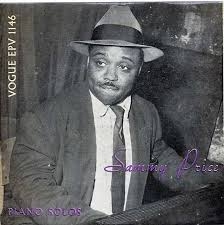Sammy Price
Pianist, Texas Bluesician, and Harlem Ward Heeler
I first heard Sammy Price at the Copley Plaza Hotel in Boston in 1985. He was around 77 by then, but still a commanding presence at the keyboard and one of the last exponents of old-school barrelhouse piano. Price played a little of everything, from rags and spirituals to stomps and boogie woogie to riff-based jazz and rock’n’roll, all of it anchored by a bedrock blues sensibility. As he told blues historian Robert Palmer, “I can play any kind of song. But I’m at my best, I think, playing the blues.”
I saw Price a few times over the next couple of years, and one night when I was featuring his music in Jazz à la Mode, I got a call from the pianist Doug Whynott who was curious to know more about Sam. As I recall, Doug assumed Price was deceased, so he was astonished when I told him Sammy was in great form just 90 miles down I-90. Whynott got on Price’s trail right away, and before long he’d befriended him and made arrangements for him to visit UMass. For the next couple of years, Sammy played some area gigs, and in 1990 he was an artist-in-residence at the University. On a couple of occasions, Doug brought Sammy to WFCR for an interview. I remember Sammy as a formidable presence, eager to talk, not too modest to boast, and protective of his legend as a player, as a participant in a golden age of African American music, as a quality control session ace at Decca Records, and, in an ancillary undertaking, as a Democratic Party ward-heeler in Harlem. I loved hearing Price’s claims about the doors he’d opened and votes he’d secured for JFK in 1960, and I’ll never forget the disgust that registered on his face at the mention of Jerry Lee Lewis’s name. The Killer had nothing on Sam when it came to rockin’ the 88’s. (Here’s Price with King Curtis and Mickey Baker in 1956.)
Today is Samuel Blythe Price’s 108th birthday anniversary. Price was born in Honey Grove, Texas, and was raised in Waco and Dallas. It was in the former where he encountered the seminal bluesman Blind Lemon Jefferson around 1918 and heard him use the term “booger rooger” to describe the style of rhythm he played on guitar. Price told Robert Palmer that Jefferson even played the types of shuffles that Texas guitarists T-Bone Walker and Gatemouth Brown would become renowned for 25 years later. Sammy barnstormed the Southwest in the late ’20s and early ’30s as a pianist and hoofer with Alfonso Trent, who led a highly renowned territory orchestra. He made his first recording, “Blue Rhythm Stomp,” in 1929 under the name, “Sam Price and His Blues Quarters,” then spent a few years in Kansas City and briefer periods in Chicago and Detroit before settling in New York in 1937. There he formed “Sam Price and His Texas Bluesicians” and became a house pianist at Decca Records. Price’s rockin’ beat gave a lift to records by the blues singer Trixie Smith and to the gospel pioneer Sister Rosetta Tharpe, and a 1941 session by the Bluesicians featured Lester Young and trumpeter Shad Collins.
Here’s the bi-lingual Price in France in 1963 introducing a performance of the Rosetta Tharpe gospel classic, “Up Above My Head.”
And here from WGBH’s former Ten O’Clock News, Christopher Lydon introduces a 1986 feature reported by Marcus Jones on “The King of Boogie Woogie.”
